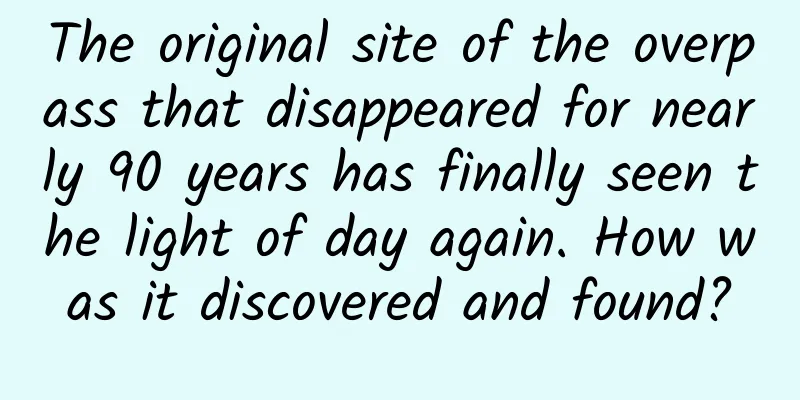The original site of the overpass that disappeared for nearly 90 years has finally seen the light of day again. How was it discovered and found?

|
Beijing's Central Axis, an axis that carries hundreds of years of history and cultural heritage, has witnessed countless changes and transitions of the times. However, as time goes by, some of the ancient architectural sites on the Central Axis have gradually disappeared. Determining the location of these sites and conducting archaeological excavations to bring these disappeared ancient buildings back to light can not only help the application for the Central Axis to be listed as a World Heritage Site, but also accumulate a batch of valuable historical treasures. Among them, the precise location and restoration of the Beijing Tianqiao ruins is a brilliant chapter in this series of efforts. Through high-precision surveying and mapping technology and unremitting archaeological exploration, scientists are like detectives traveling through time and space, unraveling the mystery of history layer by layer. Finally, the original site of the Tianqiao, which had disappeared for nearly 90 years, has been "rediscovered" in front of the world. How was the original site of the overpass, which had disappeared for nearly 90 years, rediscovered and found? First of all, the overpass is located on the central axis. We read a lot of information and found that one of the classics mentioned that there was a Longxugou crossing the overpass. The overpass was just to cross the barrier of Longxugou and connect it. So when we passed this point, we found that we needed to find where Longxugou was. Due to the development of construction, it is no longer visible on the ground. In order to find it more accurately underground, we looked for the original underground pipeline survey and historical images, such as some relevant data from the 1950s and 1970s, and then superimposed the data to do some spatial and actual analysis. By judging its material and construction age, combined with the existing data, we found the pipeline where Longxugou was at that time. At the same time, we also combined some excavations of surrounding cultural relics, such as the water-suppressing beasts recorded in the surrounding area at that time, and other information such as flying stones. By combining these with current surveying and mapping methods, we found the location we were looking for. Through these means, we try to be as precise as possible, for example, to a range of several square meters or tens of square meters. We first dig a layer to see, and then compare it with some relevant information. Then we gradually locate it accurately, conduct measurement and mapping, and verify and analyze it to prove whether our guess is correct. After the excavation, we also modeled the fan surface of some related relics. The results of the modeling can in turn guide or be used for the future protection and utilization of our heritage, forming a closed loop. For example, we use ground penetrating radar to explore the ground and analyze the material and sound wave feedback of the Tianqiao ruins. The results after modeling are also important data for the restoration and protection of cultural relics in the future. |
<<: People who blush when excited must be careful of this disease
Recommend
Air ticket prices are as low as 30 yuan. What are the reasons for the drastic drop in air ticket prices?
Because of the outbreak, many companies in many i...
What are the functions of the Guangzhou community property management mini program? How much does it cost to develop a property management app?
In order to improve the management efficiency of p...
up to date! Data rankings of 60 information flow advertising platforms!
Today I bring you the latest traffic rankings of ...
Core Animation Demos
Introduce the realization of various graphics and...
Apple and Samsung's market share has both declined. Why are domestic mobile phones rising?
In the first quarter of this year, Apple and Sams...
Cognitive neuroscience: self and social intelligence
Self and Social Intelligence ——A person has many ...
The same family, different fates! These two sea elves not only look weird, but also look alike!
For the survival and continuation of the species,...
Two key factors in user operation growth and customer acquisition!
Customer acquisition is the basis for evaluating ...
How much does it cost to rent an IDC computer room per month?
How much does it cost to rent an IDC computer roo...
APP user growth: How to use data analysis to improve user growth?
How can we make our APP stand out among a large n...
Instead of gushing out lava, they spit out mud. How much do you know about Xinjiang's mud volcanoes?
Your browser does not support the video tag The l...
Who is the prototype of the sandworm in "Dune"? The Mongolian death worm should have a name
The movie "Dune" was released not long ...
Why did such an ordinary little sand pit cause him to fall and die?
Perhaps you often see these small pits in the san...
How to quickly increase followers on Xiaohongshu?
Today I want to talk about a hot topic, as the ti...
Have you seen the latest Android phone cost-effectiveness rankings during Double 11? Meizu dominates the list
[[437968]] When it comes to cost-effective Androi...









